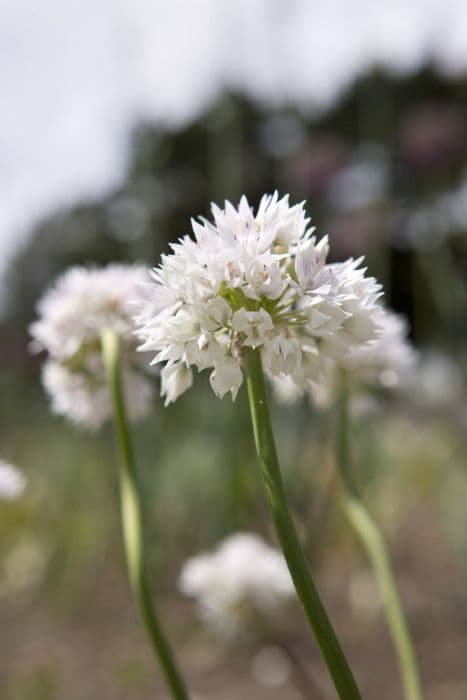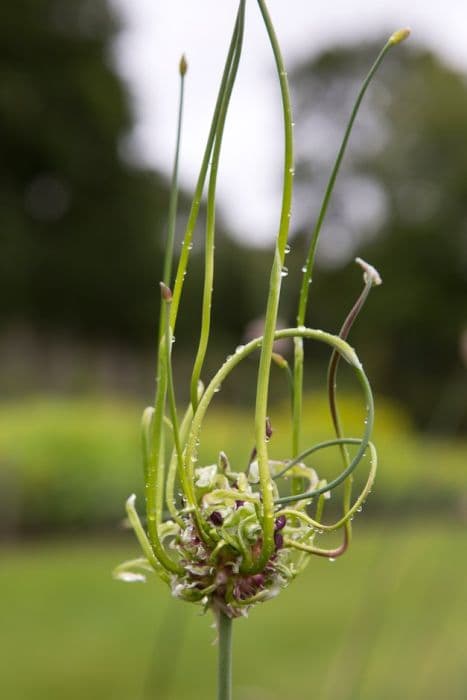Zoram onion Allium hookeri 'Zorami'

ABOUT
Allium hookeri 'Zorami' is commonly known as the Zorami or Hooker's onion. This perennial plant is characterized by its robust and vibrant appearance. The foliage consists of thick, fleshy leaves that gracefully arch outwards, similar to the common green onions but with a more substantial presence. The leaves are bright green and glossy, offering a lush texture to the plant's overall aesthetics. The Zorami produces distinctive flowers, which are of a pale cream to white color and form a rounded cluster atop sturdy flower stalks. These flowers commonly appear in an umbel-like inflorescence, which means they resemble the shape of an umbrella with individual florets connected to a single point. Each small floret adds to the spherical form of the flower head, creating an ornamental feature. As a member of the genus to which onions and garlic belong, Hooker's onion has a unique quality where both its foliage and flowers may emit a mild yet noticeable onion-like fragrance when crushed or brushed against. This characteristic can help in identifying the plant besides its visual attributes. The plant also produces bulbs underground, which are generally not visible unless the plant is uprooted. These bulbs are typical of the onion family, rounded with a slightly pointed top where the leaves emerge. Visible above the soil line could be the swollen base of the stem, which might give a hint of the bulbous nature of the plant beneath the surface. The combination of thick, luscious leaves, a bouquet of delicate flowers, and a subtle aroma give Allium hookeri 'Zorami', or the Zorami, a distinctive place in gardens and culinary uses.
About this plant
 Names
NamesFamily
Amaryllidaceae.
Synonyms
Zoram Garlic, Hooker Chives, Manipur Wild Onion, Hooker's Onion.
Common names
Allium hookeri 'Zorami'.
 Toxicity
ToxicityTo humans
Allium hookeri, commonly known as Hooker's onion, is not known to be toxic to humans. In fact, it is edible and used as a food source in some parts of the world. As with any plant or food, individuals may have allergies or intolerances that could cause adverse reactions, but generally, this plant is considered safe for human consumption.
To pets
Hooker's onion is a type of plant that belongs to the Allium family, which is known to be toxic to pets, especially cats and dogs. The toxicity is due to compounds called thiosulfates, which can cause oxidative damage to red blood cells if ingested in large quantities. Symptoms of poisoning in pets may include vomiting, diarrhea, stomach pain, drooling, lethargy, pale gums, and increased heart rate. In severe cases, ingestion can lead to hemolytic anemia, which is a serious condition and could potentially be life-threatening. If a pet ingests any part of a Hooker's onion, it is important to seek veterinary care immediately.
 Characteristics
CharacteristicsLife cycle
Perennials
Foliage type
Deciduous
Color of leaves
Green
Flower color
White
Height
1-2 feet (30-60 cm)
Spread
1 foot (30 cm)
Plant type
Herb
Hardiness zones
7
Native area
Himalayas
Benefits
 General Benefits
General Benefits- Nutritional Value: Allium hookeri 'Zorami' is a rich source of vitamins and essential nutrients required for overall health.
- Culinary Uses: Commonly known as Zoram onion, it is used as a herb or vegetable in various cuisines, adding a distinctive flavor and aroma to dishes.
- Garden Aesthetics: With its attractive flowers and foliage, it adds beauty to garden landscapes and outdoor spaces.
- Pollinator Attraction: The plant attracts bees and other pollinators, which are vital for the pollination of many other garden plants.
- Soil Improvement: Like other allium species, Zoram onion can help improve soil quality and structure through its root system.
- Companion Planting: When grown alongside other plants, it can serve as a companion plant, helping to deter certain pests with its characteristic scent.
 Medical Properties
Medical Properties- Anti-inflammatory: Contains compounds that may help reduce inflammation in the body.
- Antioxidant: Rich in antioxidants that are thought to protect cells from damage caused by free radicals.
- Anti-diabetic: There are indications that it might help in regulating blood sugar levels, although more research is needed.
- Antibacterial: Exhibits antibacterial activity which might be beneficial in preventing or treating infections.
- Immunomodulatory: It may have properties that can modulate the immune system, potentially enhancing the body's defense mechanism.
- Gastroprotective: Could provide a protective effect on the gastrointestinal system, though further studies are required to confirm such effects.
 Air-purifying Qualities
Air-purifying QualitiesThis plant is not specifically known for air purifying qualities.
 Other Uses
Other Uses- Allium hookeri, commonly known as Hooker chive, can be used in the production of natural dyes for textiles, providing a range of colors depending on the mordant used.
- Its fibrous leaves can be woven into bio-degradable garden twines or cords, serving as a sustainable option for supporting climbing plants.
- Hooker chive’s residual plant matter after harvesting can serve as mulch, contributing to soil moisture retention and weed suppression.
- The strong aromatic properties of the plant can be harnessed in potpourris or natural insect repellent formulations for household use.
- Its seeds, when dried and crushed, may be used in homemade spice mixes, adding a unique flavor to various culinary dishes.
- The plant's aesthetic flowers make it a suitable candidate for ornamental purposes in garden borders or as part of a wildflower meadow mix.
- Due to its robust nature, Hooker chive can be utilized in erosion control, as it can anchor soil with its widespread root system.
- Practitioners of natural crafts might use dried Hooker chive stalks as a structural element in creating eco-friendly art pieces.
- As part of companion planting strategies, the strong scent of Hooker chive may help mask more desirable plants from pests, reducing the need for chemical deterrents.
- The plant can play a role in educational gardens or botany programs, serving as an example of edible landscaping and permaculture practices.
Interesting Facts
 Feng Shui
Feng ShuiThe Allium hookeri is not used in Feng Shui practice.
 Zodiac Sign Compitability
Zodiac Sign CompitabilityThe Allium hookeri is not used in astrology practice.
 Plant Symbolism
Plant Symbolism- Resilience: Allium hookeri, commonly known as 'Zorami,' is known for its hardy nature and ability to thrive in challenging conditions, symbolizing the capacity to endure and bounce back.
- Protection: Many Allium species have been traditionally believed to possess protective qualities, warding off negativity and evil spirits.
- Healing: With its medicinal properties, the 'Zorami' is often associated with healing and wellness, reflecting the plant's role in traditional herbal remedies.
- Purity: The bulbous nature of Alliums represents purity and honesty, with 'Zorami' echoing these qualities through its clean lines and simple form.
 Water
WaterThe Manipuri onion, commonly known as Allium hookeri 'Zorami', prefers to be watered once the top inch of soil begins to dry out. This typically means watering it with about 1 to 2 gallons of water every week during the active growing season, but frequency may decrease to every other week during cooler months or when the plant is not actively growing. It's essential to water the plant thoroughly, allowing the water to reach deep into the soil to encourage deep root development, while avoiding waterlogging. Always check the soil moisture before watering to prevent overwatering, which can lead to root rot.
 Light
LightThe Manipuri onion thrives best in a location with full sun to partial shade, meaning it should receive direct sunlight for at least 6 to 8 hours a day. A spot where the morning sun's gentle rays can reach it, followed by light shade in the harsh afternoon, is ideal for this plant. Avoid dense shade areas as insufficient sunlight can hinder its growth and reduce the robust flavor of its leaves.
 Temperature
TemperatureThe Manipuri onion prefers temperate climates with temperatures ranging between 50°F to 75°F, which are considered ideal for its growth. It can tolerate minimum temperatures down to approximately 28°F but may suffer damage if exposed to freezing conditions for prolonged periods. The plant is hardy and can withstand colder temperatures, but it's vital to protect it from frost to ensure its healthy growth and development.
 Pruning
PruningPruning the Manipuri onion is necessary to remove dead or yellowing leaves and promote healthy growth. Trimming back the foliage and spent flower stalks can be done in late fall or early spring, and it is generally recommended to prune minimally, only as needed to maintain the plant's compact shape. The best time for a more thorough pruning would be immediately after flowering, when you can cut back the flower stalks to ground level to encourage fresh growth.
 Cleaning
CleaningAs needed
 Soil
SoilZorami, commonly known as the Hooker chive, thrives in well-draining soil with a rich blend of compost or aged manure. A balanced soil pH of around 6.5 is ideal. Incorporating sand or perlite ensures good drainage, and a top dressing of organic matter can promote healthy growth.
 Repotting
RepottingHooker chive should be repotted every 2-3 years to refresh the soil and accommodate its growing root system. Spring or early summer is the best time to repot, allowing the plant to establish in the new container before the growing season.
 Humidity & Misting
Humidity & MistingHooker chive prefers moderate humidity levels. It isn't particularly demanding, but ensuring that the ambient humidity is between 40% to 60% will simulate its native growing conditions and promote healthy growth.
 Suitable locations
Suitable locationsIndoor
Place Hooker chive in bright light and well-draining soil indoors.
Outdoor
Grow Hooker chive in full sun to partial shade, in rich soil.
Hardiness zone
3-9 USDA
 Life cycle
Life cycleAllium hookeri 'Zorami', commonly known as Zoram tulsi, begins its life cycle as a seed, which upon germination, develops into a small seedling with characteristic narrow leaves. The seedlings grow into mature plants, forming clumps and bulbs underground as they enter the vegetative stage. During the growth period, they produce elongated leaves and in some cases, may also form offsets. The reproductive stage begins when the plant sends up a flower stalk, culminating in star-shaped flowers that attract pollinators, leading to seed production. After flowering, the plant goes into senescence, where the aerial parts die back, while the bulb can remain dormant underground before the next growth cycle. The plant can also propagate vegetatively through bulb division, allowing new individual plants to arise from the parent clump.
 Propogation
PropogationPropogation time
Spring-Early Summer
The most popular method of propagation for Allium hookeri, commonly known as Zorami leek or Hooker's onion, is by division. This should ideally be done in the spring or early fall when the plant is not actively growing. To propagate by division, carefully dig up the clumps of bulbs and gently separate them by hand. Each division should have at least one bulb or a piece of the rhizome with roots intact. Replant the divisions immediately at a depth of about 2 inches (approximately 5 centimeters), spacing them roughly 6 to 8 inches apart (15 to 20 centimeters), in well-draining soil with direct sunlight to partial shade. Water the newly planted divisions thoroughly to establish them. This method allows for a quick and efficient way to increase the number of plants and maintenance of existing clumps by rejuvenating overgrown areas.








